Keywords
|
| Object Detection, Frame Differencing, Background Subtraction, Morphological Operation, Object Tracking, Template Matching. |
INTRODUCTION
|
| There has been an increase in various crimes and mishaps such as robbery, kidnapping, bomb blasts, terrorist attacks which arises the need of Security in public areas such railway stations, air ports, banks, historical places, parking. So as to keep an eye on suspicious activities or persons there is a need of continuous surveillance. In case of emergency continuous surveillance is of prime importance so as to alert and to catch the responsible. Since the up till date monitoring systems are incapable of handling real time processing because of lower efficiency and higher costs. There is a need for smart real time video surveillance systems which can respond in prime time. |
| Thus there is need of Object Detection and Tracking. Now how do we know which object is to be detected and tracked. This shifts our concern to the object of interest. Basically for analysing a video there is need to detect the mobile object from one video frame to another and further recognizing it. For detecting an object its representation is of utmost importance as objects may have varied shapes, sizes, colours pin pointing to their appearances. An object of interest is namely the object of concern in a video frame which is to be tracked. Up to the present date object tracking has the following extensive applications: |
| ? Automatic Object Recognition that is determining the class of object. |
| ? Human identification based on motion trajectory |
| ? Detection of suspicious events automatically |
| ? Real time Traffic monitoring |
| ? Obstacle avoidance based on path estimation |
| ? Gesture recognition |
| ? Retrieving videos from multimedia databases Tracking can be defined be simply defined as following the object. Object tracking corresponds to tracking of single or multiple objects in consecutive frames. |
| Difficulties undergone in tracking are: |
| ? abrupt object motion |
| ? noise in images |
| ? changing appearance patterns of object and the scene (illumination) |
| ? non-rigid object structures |
| ? occlusion |
| ? camera motion |
| ? Real-time processing requirement |
| The present concept is of using both frame differencing and background subtraction effectively and accurately for detecting moving objects in a sequence of frames. The frame differencing method takes into account the velocity of the moving object in order to find the number of frames to be skipped in each stage of detection to calculate inter -frame difference in order to get the region of moving object. After detecting the centroid information of the object is forwarded to the set up so as to track the object in frame sequence using dynamic template matching. Dynamic template matching establishes a correlation function in order to track the detected object in frame sequences. When the tracking fails the algorithm goes back to detection module and the process repeats. Proposed system is effective while tracking the object of interest far away from the camera independent of the motion of the object. Further binary thresholding, morphological erosion and dilation operation are implemented in order to remove insignificant movement due to camera flickering and to remove noise. The obtained image is precisely denotes the moving object region. Proposed system implies tracking of multiple Vehicles using Simulink Model and single Human tracking using Matlab. |
RELATED WORK
|
| Tracking has been an active research topic for decades and review of all the tracking methods is impossible. So some papers related to the proposed system are mentioned as below: |
| Jialue Fan and Xiaohui Shen [1] proposed a unified method for single object tracking in which target category is actively recognized. High level offline model is combined with low level online model to achieve better tracking performance. The proposed method outperforms in many challenging tracking scenarios where view changes drastically or for scale change or for background fluctuation and morphable objects. Limitations of proposed method are the ambiguity of tracking problem increases as the number of object categorized increases, the wrong recognition result probably leads to error propagation, the current design may not be appropriate for some tracking dataset due to data type inconsistency. |
| Karan Gupta and Anjali Kulkarni [2] presented a robust and efficient automated single object tracking system. The system has been implemented using an algorithm based on frame differencing and dynamic template matching. The algorithm has experimentally been shown to be quite accurate and effective in detecting a single moving object even under bad lighting conditions or occlusions. The system has been automated using a pan-tilt setup which is synchronized with the algorithm. Such an automated object tracking system can be used in applications where accurate tracking is required but good lighting conditions cannot be provided. The system is applicable to areas like surveillance and video conferencing. |
| Alper Yilmaz and Omar Javed [3] presented Object Tracking as a SURVEY. This article presents an extensive survey of object tracking methods and also gives a brief review of related topics. They divide the tracking methods into three categories based on the use of object representations by methods establishing point correspondence, methods implementing primitive geometric models, and methods using contour evolution. All these classes require object detection at some point. A detailed summary of object trackers, including discussion on the object representations, models relating motion, and the schemes estimating parameter employed by the tracking algorithms is provided. They mentioned the use of context, degree of applicability, criteria for evaluation, and comparisons qualitative factor. |
| Ismail Haritaoglu and David Harwood [4] proposed real time visual surveillance system implemented in outdoor environment for detecting and tracking people and monitoring their activities. It operates on single gray scale video imagery or on video imagery from an infrared camera. This system makes no use of colour cues. Instead employs a combination of shape analysis and tracking to locate people and their parts (head, hands, feet, and torso) and to create models of people's appearance so that they can be tracked through interactions such as occlusions. This system is capable of simultaneously tracking multiple people even with occlusion. It runs at 25 Hz for 320x240 resolution images on a dual-pentium PC. |
| G. Mallikarjuna Rao and Dr. Ch. Satyanarayana [5] dealt with the tracking of single object in a sequence of frames either from a live camera or from videos saved previously. A moving object is detected in each frame with high accuracy and efficiency using Median approximation technique. Further Kalman filter estimation is used for tracking the detected object along with a more accurate Template Matching algorithm. For this templates are generated dynamically which guarantees any change in object pose which does not be hindered from tracking procedure. Entry and exit of the object are handled efficiently. |
| Prerna Rajput and Vikas Tripathi [6] present various algorithms for motion detection, object classification, objects tracking and action recognition. A novel approach is presented for detecting vehicles and pedestrians based on haar features. The rectangle areas are multiplied by their weights and then added to calculate the value of Haar feature. Object detection using haar classifier provides robust and effective results. Median filtering algorithm would be suitable for monitoring an indoor scene environment; however, same algorithm is not proper choice for outdoor scene environment. |
| N. Prabhakar and V. Vaithiyanathan [7] proposed object tracking system using concepts of frame differencing and template matching. For detecting moving object difference between frames is taken. For tracking the detected object Template matching algorithm is used. The dynamic templates are used for matching purpose which ensures that the change in orientation and position of object does not hinder the tracking system. This study presents an effective way to detect the moving body of interest, discarding the smaller unwanted objects causing false alarms during implementation. Further, this study also presents a way to track an interested object, from a group of moving and detected object, in the subsequent frames of the continuous video stream. This method is suitably and efficiently applicable to darker objects over light background. For the reverse condition, i.e., for lighter object over dark background, a slight shift in the position of the detected object is being observed. |
| Rahul Mishra and Mahesh Chauhan [8] proposed an approach for tracking multiple objects in single frame in which the centroid of objects are taken as central component. The feature histogram based target representations are regularized by isotropic kernel. The target localization problem is formulated by attraction of local maxima. But feature information is not sufficient for enhance localization therefore some structure information is added to the traditional method of tracking. This method is successfully adjusted with moving camera, Partial occlusions and changing scale and orientation of target. |
| R. Venkatesh Babu and Patrick Perez [9] proposed a new method to track objects by combining two well-known trackers, sum-of-squared differences (SSD) and colour-based mean-shift (MS) tracker. These when combined compensate for disadvantage of each other. MS tracker overcomes the rapid model change in SSD tracker. Also MS tracker is incapable of handling large displacements which in turn is handled by SSD tracker. The performance of the combined tracker enhances the process of tracking for fast moving object than those of the individual trackers. The performance of the tracker is hindered when the object is partially occluded since global parameters such as colour are taken into consideration. Thus the MS tracker is used to track Local parameters instead of global. In order to update MS tracking module likelihood ratio weighting is used. |
PROPOSED SYSTEM
|
| 1. Video as an input is either taken from online mode or offline mode. |
| 2. Video is converted to number of frames. |
| 3. In order to detect moving object frame difference algorithm is applied. Here for detecting slow moving object i th frame is subtracted from (i-3)th frame. |
| 4. Further apply Binary Thresholding Operation so as to separate moving object pixels from background and morphological operations such as erosion and dilation for avoiding detection of non-stationary objects. |
| 5. Determine the centroid for the position of moving object in the given scene. |
| 6. An image template is extracted from last frame grabbed by the camera implementing Dynamic Template Matching Algorithm. |
| 7. The position of the tracked object is passed to camera set-up and camera moves left-right and up-down on basis calculated co-ordinates. |
FLOWCHART
|
| The section below mentions important terms and steps implemented for detection and tracking of an interested moving object. |
| A. Frame Differencing : |
| The positional location of the moving object is determined by frame differencing. Also we can detect an object by using Simulink Model. As there occur abrupt changes in appearance of the object a template is generated. The critical task here is to identify the moving object in continuous frame sequences. The need of image acquisition loop is emphasized because of the presence of large frame sequences in online as well as offline mode. The later frame is subtracted from the reference frame. For this purpose image subtraction operator is used. For calculation purpose consider frame F2(i,j) and subtract it from frame F1(i,j) . And the result will be stored in frame S(i,j). |
| S(i,j) = F1(i,j) - F2(i,j) |
| The designed algorithm must be adaptive to handle the sudden changes in illumination of scenarios such as shadows, moving leaves, snow and rain. Also it must be free from unwanted noise clutter. In order to overcome these problems preprocessing is employed. Preprocessing includes different types of thresholding and morphological operations. The image acquisition tool grabs RGB image. Hence to reduce the number of bits we are converting into gray scale image. We use Gray threshold to calculate thresholds in image. Further morphological operation such as erosion and dilation are applied. These operations are performed to remove background inaccuracies. Object detection provides with positional location of the object for tracking. |
| B. Template Matching: |
| For tracking purpose we need to match the template of tracking system with the object detected. Detection process provides the positional co-ordinates of the object that will help us for template matching. Template matching can be referred to as a search method. It searches an image for a similar object template defined in a previous frame. Templates generally taken into consideration are image intensity or image gradient or color features. Here in order to minimize the high computational cost we use bounding box to represent the object. |
| C. System Flowchart: |
| Following flowchart represents the steps of proposed work. |
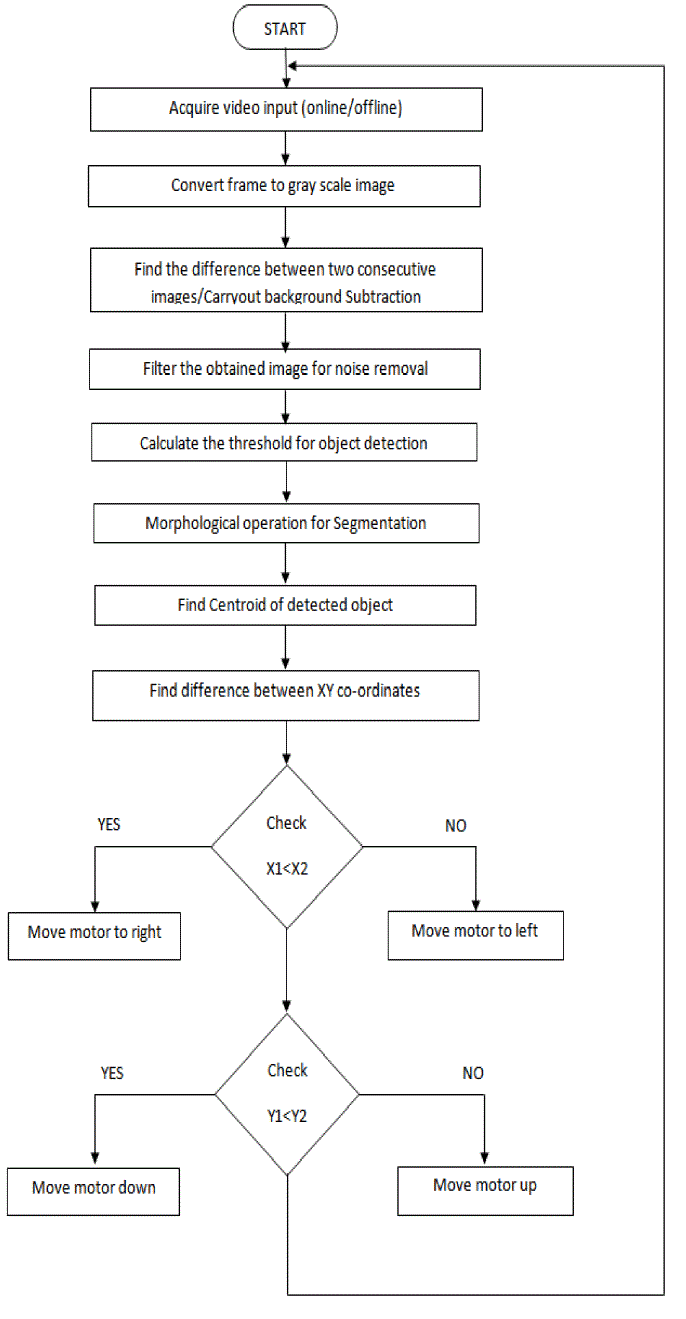 |
| D. Hardware Implementation: |
| The Camera setup operates the motors so as to track object in motion. The stepper motors help in horizontal and vertical movement of the set up. Tracking program controls the motor driver circuit through parallel port interface. The driver circuit comprises of ULN 2003 IC. |
CONCLUSION
|
| Detection and Tracking are vast topics to discuss. We have reviewed various methods for Object Detection and Tracking such as Object Representation, Feature selection, Frame Differencing, Background Subtraction and Trajectory estimation. We have gone through various Digital Imaging tools such Matlab and Simulink. |
ACKNOWLEDGEMENT
|
| I would like to present my honest gratitude to Prof. A. P. Bodkhe and Prof. S. A. Nirmal for their immense support and guidance throughout the work. |
Figures at a glance
|
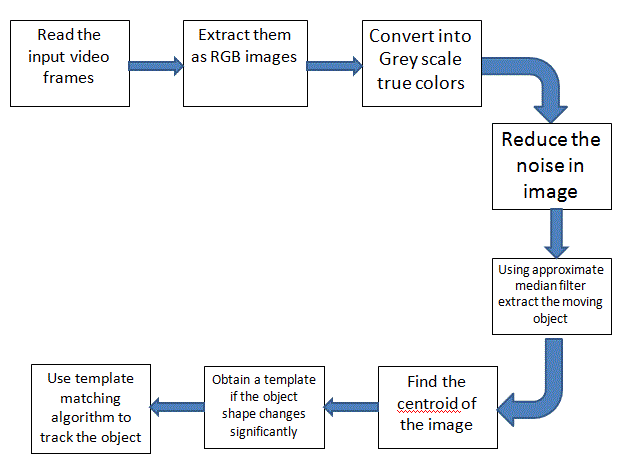 |
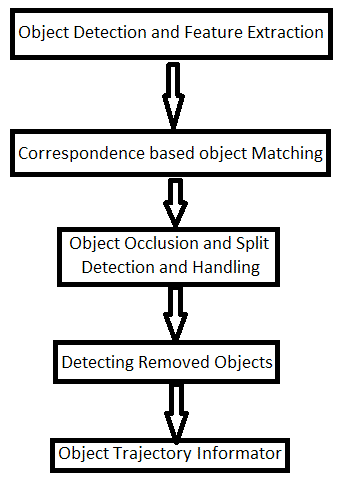 |
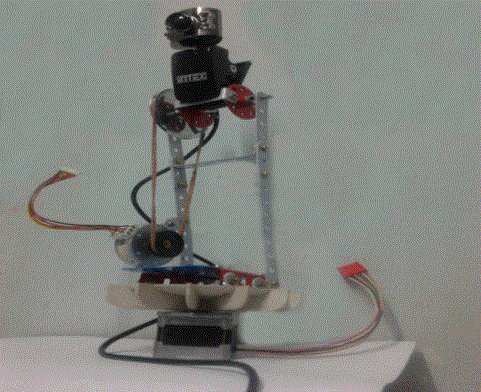 |
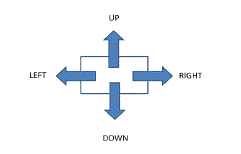 |
| Figure 1 |
Figure 2 |
Figure 4 |
Figure 5 |
|
References
|
- Jialue Fan, Xiaohui Shen and Ying Wu, " What are we Tracking: A Unified Approach of Tracking and Recognition", IEEE Transactions on Image Processing, Vol.22, No.2, pp. 549-560, 2013.
- Karan Gupta, Anjali V. Kulkarni, “Implementation of an Automated Single Camera Object Tracking System using Frame differencing and Dynamic Template Matching”, International Joint Conferences on Advances in Computer, Information, System Sciences and Engg. Sponsored by IEEE, Bridgeport, pp. 245-250, 2007.
- Yilmaz, O. Javed and M. Shah, "Object Tracking: A Survey", ACM Comput. Surv. Vol.38, No.4, pp.1-13, 2006.
- Ismail Haritaoglu, David Harwood and Larry S. Davis, “W 4: Who? When? Where? What? A Real Time System for Detecting and Tracking People”, IEEE Transaction on Patt. Analy. Mach. Intell, Vol. 22, No. 8, pp. 809-830, 1998.
- G. Mallikarjuna Rao and Dr.Ch.Satyanarayana, “Object Tracking System Using Approximate Median Filter, Kalman Filter and Dynamic Template Matching”, I.J. Intelligent Systems and Applications,Vol.6, No.5, pp. 83-89, 2014.
- Prerna Rajput and Vikas Tripathi, “New Trends in Object Motion Analysis”, International Journal of Advanced Research in Computer Science and Software Engineering, Vol.4, No.4, 2014.
- N. Prabhakar, V. Vaithiyanathan and Akshaya Prakash Sharma, “Object Tracking Using Frame Differencing and Template Matching”, Research Journal of Applied Sciences, Engineering and Technology, Vol.4, No.24, pp. 5497-5501, 2012.
- Rahul Mishra, Mahesh K. Chouhan, Dr. Dhiiraj Nitnawwre, “Multiple Object Tracking by Kernel Based Centroid Method for Improve Localization”, I.J of Advanced Research in Computer Science and Software Engineering, Vol.2, No.7, pp. 137-140, 2012.
- . R. Venkatesh Babu , Patrick Perez and Patrick Bouthemy ,“ Robust tracking with motion estimation and local Kernel-based color modeling”, Elsevier, Vol. 25, No. 8, pp. 1205-1216, 2007.
- Richard Y.D. Xu, John G. Allen, Jesse S. Jin, "Robust real- time tracking of non-rigid objects", Proceedings of the Pan-sydney area workshop on Visual Information processing, Vol. 36, pp.95-98, 2004.
- S. Avidan, "Ensemble Tracking", IEEE Trans. Pattern Anal. Mach. Intell, Vol.29, No.2, pp.261-271, 2007.
- Babenko, M-H. Yang and S. Belongie, "Visual tracking with online multiple instance learning ", in Proc. Conf. Comput. Vis. Pattern Recogni., pp. 983- 990, 2009.
- H. Grabner, M. Grabner and H. Bischof, "Real-time tracking via online boosting", in Proc. British Mach. Vis. Conf., pp.1-10,2006
- Y. Li, H. Ai, T. Yamashita, S. Lao and M. Kawade, " Tracking in low frame rate video: A Cascade particle filter with discriminative observers of different life spans", IEEE Trans. Pattern Anal. Mach. Intell., Vol.30, No. 10, pp. 17288-1740, 2008.
|